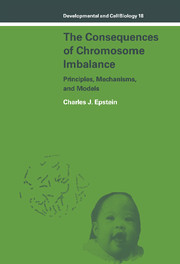Book contents
- Frontmatter
- Contents
- Preface
- Glossary
- PART I INTRODUCTION
- PART II CLINICAL OBSERVATIONS
- PART III THE THEORETICAL MECHANISMS AND ISSUES: THE PRIMARY AND SECONDARY EFFECTS OF ANEUPLOIDY
- PART IV EXPERIMENTAL SYSTEMS FOR THE STUDY OF MAMMALIAN AND HUMAN ANEUPLOIDY
- PART V THREE MAJOR CLINICAL PROBLEMS OF HUMAN ANEUPLOIDY
- PART VI CONCLUSION
- 15 Principles, mechanisms, and models
- Appendix: Standard karyotypes of man and mouse and human cytogenetic nomenclature
- References
- Index
15 - Principles, mechanisms, and models
Published online by Cambridge University Press: 14 October 2009
- Frontmatter
- Contents
- Preface
- Glossary
- PART I INTRODUCTION
- PART II CLINICAL OBSERVATIONS
- PART III THE THEORETICAL MECHANISMS AND ISSUES: THE PRIMARY AND SECONDARY EFFECTS OF ANEUPLOIDY
- PART IV EXPERIMENTAL SYSTEMS FOR THE STUDY OF MAMMALIAN AND HUMAN ANEUPLOIDY
- PART V THREE MAJOR CLINICAL PROBLEMS OF HUMAN ANEUPLOIDY
- PART VI CONCLUSION
- 15 Principles, mechanisms, and models
- Appendix: Standard karyotypes of man and mouse and human cytogenetic nomenclature
- References
- Index
Summary
It gradually dawned on us that what we eventually came to identify as a “differentiated” cell of a given type, shape, structure, colour, and behavior, was really just the last scene of a long play of interactions, the earlier stages of which had been hidden from us. We came to realize that, in dynamic terms, the so-called “stages” of the development of a cell, an embryo, or a disease, represented simply cross-sections through a continuous stream of processes, recorded by whatever methods of assay and portrayal – whether in pictures or in graphs – we had at hand. The picture of an overt “character” thus emerged as merely the residual index of prior covert dynamics; “form,” as the registered outcome of formative processes.
(Weiss, 1973)So also with aneuploidy and its effects. What we observe as the phenotypes associated with unbalanced chromosome abnormalities represent but the end results of the lifelong impacts of specific types of genetic imbalance on the normal processes of development and function. Therefore, complete understanding of how aneuploidy produces its effects will ultimately require a full knowledge of how normal development and everyday functioning are genetically controlled – a goal whose attainment is clearly still far in the future. Nevertheless, we are beginning to discern some of the principles or rules which govern the development of aneuploid phenotypes and to appreciate some of the mechanisms whereby genetic imbalance may affect development and function.
- Type
- Chapter
- Information
- The Consequences of Chromosome ImbalancePrinciples, Mechanisms, and Models, pp. 369 - 380Publisher: Cambridge University PressPrint publication year: 1986
- 3
- Cited by



